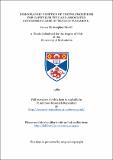Files in this item
Demographic genetics of the polymorphism for capitulum type and associated outcrossing rate in 'Senecio vulgaris L.'
Item metadata
| dc.contributor.advisor | Abbott, Richard J. | |
| dc.contributor.author | Horrill, James Christopher | |
| dc.coverage.spatial | 144 p. | en_US |
| dc.date.accessioned | 2018-06-21T13:32:49Z | |
| dc.date.available | 2018-06-21T13:32:49Z | |
| dc.date.issued | 1989 | |
| dc.identifier.uri | https://hdl.handle.net/10023/14403 | |
| dc.description.abstract | The primary aim of this project was to examine factors which are likely to provide a mechanism by which the polymorphism for capitulum type and associated outcrossing rate in Senecio vulgaris may be maintained. The majority of studies conducted examined the demographic genetics (i.e. the changes in the number of individuals of the two morphs at different life history stages) in field experiments initiated either in Spring or Autumn, The first series examined the demography of each morph raised from seedlings to senescence in pure stand and mixture. The second series examined the demography of each morph from seed to senescence and thereby investigated the effect on fitness of any difference between morphs in germination behaviour. The importance of inbreeding depression on the maintenance of the polymorphism was examined by comparing the relative fitness of self and open pollinated offspring of each morph under glasshouse conditions. Germination behaviour of seeds of each morph was also investigated in a series of field trials conducted over an extended period. These field studies were complemented by a series of synchronous laboratory studies to examine the effect of temperature on morph germination behaviour. It was found that inbreeding depression is not an important factor in the maintenance of the polymorphism. No short term advantage of the radiate over the non-radiate morph was evident in the first series of demography experiments. The germination studies showed that differences between morphs in germination behaviour may occur frequently in autumn sown seed. The second series of demography experiments showed that under certain conditions this difference in germination can lead to the radiate morph attaining a greater relative fitness than the non-radiate morph. Temperature was found to be a major factor controlling the initial dormancy of seeds after sowing. It is concluded that the difference between morphs in germination behaviour is the most likely factor that could maintain the polymorphism for capitulum type in Edinburgh populations of 8. vulgaris. | en_US |
| dc.language.iso | en | en_US |
| dc.publisher | University of St Andrews | |
| dc.subject.lcc | QK828.P7H7 | en |
| dc.subject.lcsh | Plants—Reproduction—Molecular aspects | en |
| dc.title | Demographic genetics of the polymorphism for capitulum type and associated outcrossing rate in 'Senecio vulgaris L.' | en_US |
| dc.type | Thesis | en_US |
| dc.contributor.sponsor | Science and Engineering Research Council (SERC) | en_US |
| dc.type.qualificationlevel | Doctoral | en_US |
| dc.type.qualificationname | PhD Doctor of Philosophy | en_US |
| dc.publisher.institution | The University of St Andrews | en_US |
This item appears in the following Collection(s)
Items in the St Andrews Research Repository are protected by copyright, with all rights reserved, unless otherwise indicated.

